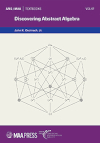- About MAA
- Membership
- MAA Publications
- Periodicals
- Blogs
- MAA Book Series
- MAA Press (an imprint of the AMS)
- MAA Notes
- MAA Reviews
- Mathematical Communication
- Information for Libraries
- Author Resources
- Advertise with MAA
- Meetings
- Competitions
- Programs
- Communities
- MAA Sections
- SIGMAA
- MAA Connect
- Students
- MAA Awards
- Awards Booklets
- Writing Awards
- Teaching Awards
- Service Awards
- Research Awards
- Lecture Awards
- Putnam Competition Individual and Team Winners
- D. E. Shaw Group AMC 8 Awards & Certificates
- Maryam Mirzakhani AMC 10 A Awards & Certificates
- Two Sigma AMC 10 B Awards & Certificates
- Jane Street AMC 12 A Awards & Certificates
- Akamai AMC 12 B Awards & Certificates
- High School Teachers
- News
You are here
Discovering Abstract Algebra

Buy Now:
Publisher:
AMS
Publication Date:
2021
Number of Pages:
199
Format:
Paperback
Series:
AMS/MAA Textbooks
Price:
69.00
ISBN:
978-1-4704-6442-4
Category:
Textbook
[Reviewed by , on ]
Kevin Gerstle
01/10/2022
Most undergraduate math textbooks are written with the mindset of being used in a more traditional classroom where students sit through lectures before being sent out to work through problems on their own. However, more and more professors are turning to approaches in inquiry-based or active learning where students are actively involved in each class working with each other, presenting problems, and discovering mathematics themselves rather than being told about math by someone with far more experience.
For those instructors with an interest in the latter type of class, Discovering Abstract Algebra provides an excellent collection of examples, exercises, and theorems to prove in the field of abstract algebra. This book is appropriate for students with at least one course in both linear algebra and proof-writing. From the first page, students are expected to be able to prove a variety of mathematical statements from the given definitions and axioms with little help on how to write a proof in the first place. For students with experience in writing proofs, however, the theorems are laid out in a way that allows students to build new results from old ones and guides students in creating the major results in elementary abstract algebra themselves.
Where this text most excels is in building a sequence of exercises in the body of the chapter rather than placing them at the end like in more traditional textbooks. This approach forces the students to work constantly to prove theorems and solve problems throughout the reading process rather than passively sitting through large chunks of information before completing selected exercises at the end of a chapter. This book is clearly designed with inquiry-based learning in mind and in its introduction suggests a variety of ways this book could be incorporated into more active classrooms settings through group work, presentations, and flipped classrooms.
The book’s content covers introductory and intermediate group theory, elementary ring theory, some field theory, and the theory of abstract vector spaces. It pays particularly careful attention to group theory while omitting other topics sometimes found in an undergraduate abstract algebra course such as irreducibility criteria, principal ideal and unique factorization domains, and Galois theory. The topics the book chooses to discuss, however, are discussed in great detail and with a plethora of examples for students to play around with and theorems to prove.
Overall, I recommend this work to professors teaching a one-semester undergraduate abstract algebra course that are looking for a resource that takes an active approach to learning by guiding students through proving every theorem themselves rather than working most of them out for the students. It works particularly well for a course centered around group work or having students present problems to each other. It is not recommended for students that have not had any experience in proof-writing or for more advanced coursework in abstract algebra. While it does not cover as many topics as Gallian’s Contemporary Abstract Algebra or Fraleigh’s A First Course in Abstract Algebra when it comes to ring theory and field theory, Discovering Abstract Algebra provides a more student-driven experience that excels at giving motivated students the opportunity to explore and discover abstract algebra for themselves.
Kevin Gerstle is an assistant professor at Hillsdale College. His professional interests are in the study of representation theory and Brownian motion.
See the publisher's website.
- Log in to post comments




